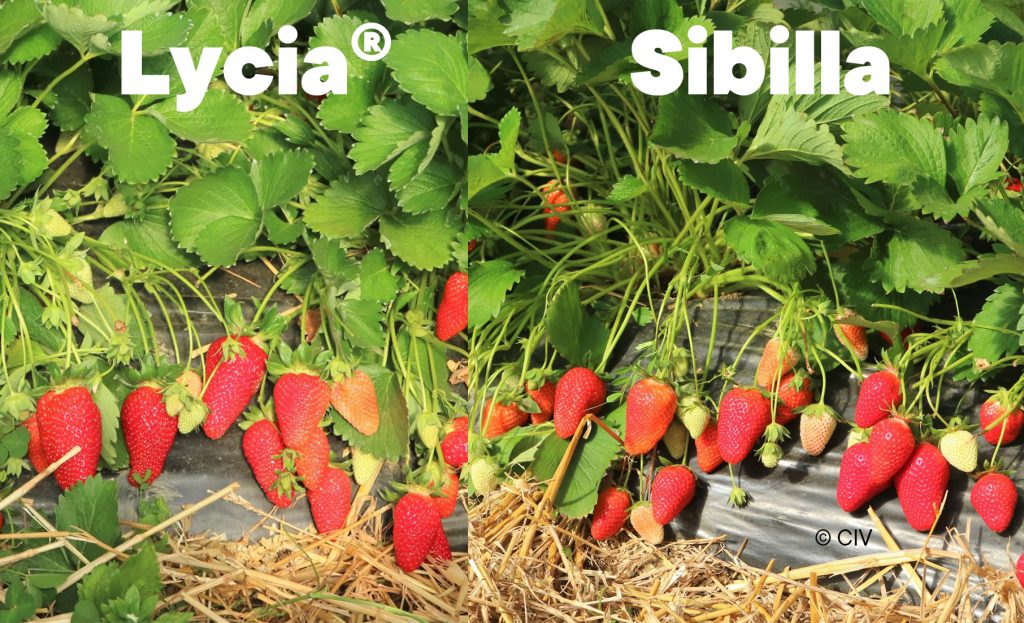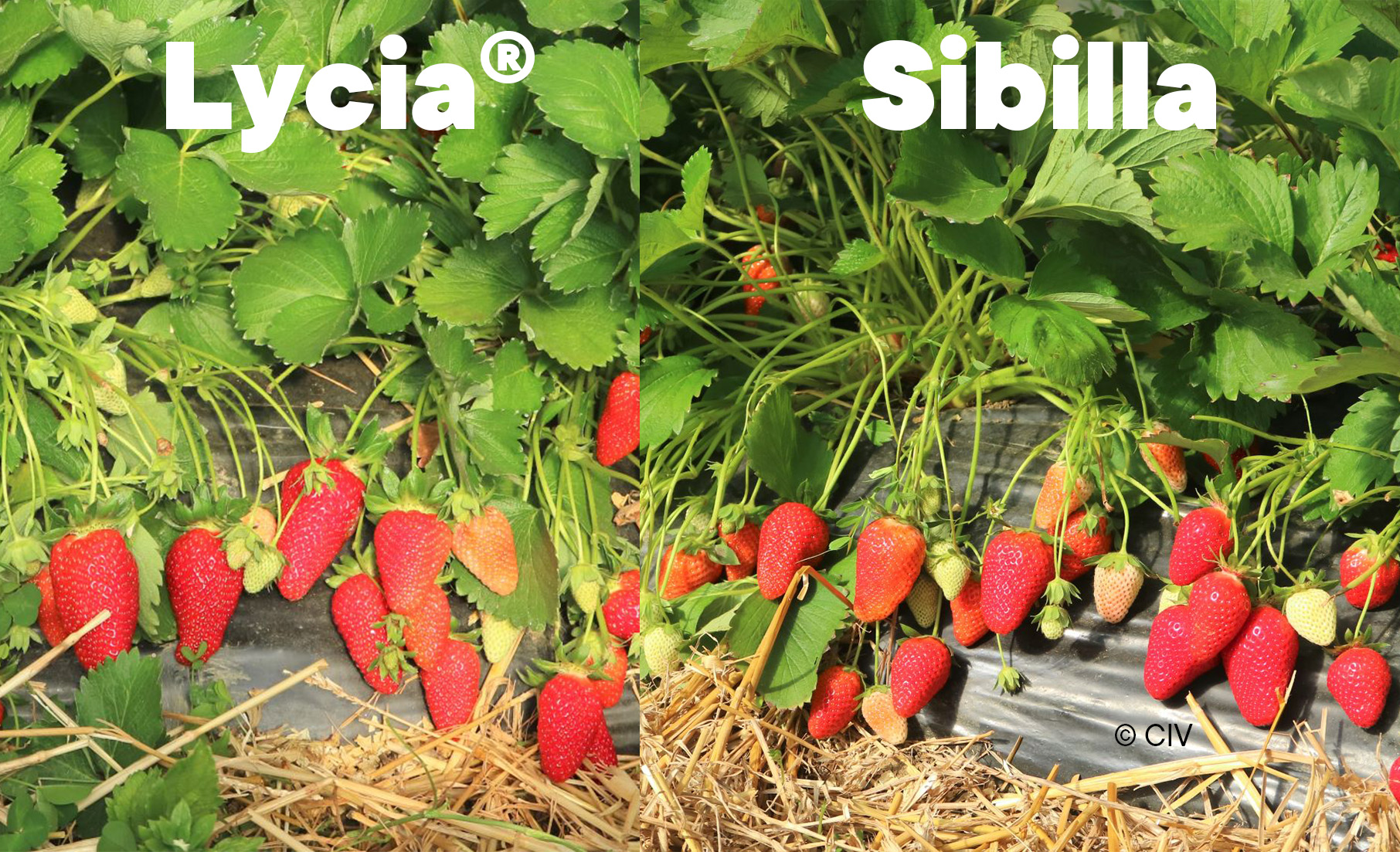Lycia®CIVNB557* and Sibilla*: two CIV strawberries that make the difference in Italy
Although the south of Italy is home to the largest areas (Caserta and Policorese) for the country’s strawberry cultivation, Romagna, the historical cradle of Italian strawberry cultivation, remains essential for the cultivation of high-chill June bearer varieties.
The CIV breeding nursery (Consorzio Italiano Vivaisti), which has always been a leader in the development of varieties in this category, is delighted with the success of its Lycia® CIVNB557* and Sibilla*, as testified by two producers from Cesena.
Loris Benvenuti, who has long been growing CIV varieties and has closely followed the Lycia® CIVNB557* variety since its early stages of development, reports his extremely positive experience of the current harvest.
“In general, as far as the characteristics of the plant are concerned, Lycia® CIVNB557* differs from the traditional June bearer varieties for northern Italy due to its compact habitus. In fact, the plant has a semi-erect habit that facilitates production both in open field and tunnels. Moreover, like many varieties of CIV, it is characterized by an excellent rusticity of the plant and tolerance to powdery mildew and fungal diseases, which allow its cultivation even in tired soils, like mine, where strawberry monoculture has been repeated for over twenty years.”
As for ripening, “in terms of precocity, the harvest begins eight to ten days after Clery* (start of harvest: 5-6 April). One of the great advantages of Lycia® CIVNB557* is undoubtedly the wide harvesting window, i.e. a long on-plant ripe life of the fruit, which does not deteriorate quickly if not harvested promptly. In addition, the wide harvesting window and the short fruit stem make harvesting easier, less expensive and more manageable, allowing the plant to accumulate more sugar in the fruit, which becomes sweeter and remains crunchy. To give a practical indication, in my company we harvest every 3-4 days on average. Lycia® CIVNB557 can be harvested without problems even on the fifth or even sixth day since the previous harvest.”
Regarding the characteristics of the fruit, Benvenuti said, “The sweetness and taste are good even when the variety is harvested for business needs not fully ripe. Instead, when harvested at the physiologically correct time, Lycia® CIVNB557* develops an excellent taste with a sugar degree that on average is between 8 and 9 degrees Brix. Both the elongated shape and the high flesh firmness remind some traits of strawberries cultivated in Southern Italy. Finally, the high flesh firmness allows the fruit to be marketed without it being easily damaged. The colour of the fruit is bright red and never reaches, even in late harvests, dark colours.”
Benvenuti concludes by describing some aspects of commercial relevance: “The variety is suitable for both cultivation in tunnels and open field. In terms of production, to date, May 12th, production is around 800 g per plant in a tunnel and I am confident that the kg/plant ratio can be exceeded. The shape and flesh firmness, recalling the typical characteristics of low-chill varieties (cultivated in southern Europe) that have captivated Italian consumers for years, and the high organoleptic properties of the fruit will allow Lycia® CIVNB557* to enter a premium segment in the variety scene of northern Italy.”
The second testimony comes from producer Antonio Benzi, who has been growing the Sibilla variety for several seasons now. “The increasingly unpredictable and highly variable climate this year has fortunately not caused any problems. Many producers are looking for precocity, but for me the strawberry comes in May. Sibilla, which is certainly not among the earliest varieties, in my area has an open-field flowering time that starts in mid-April, when the risk of late heavy frosts is relatively low. In fact, this year the late frost events that we had in spring did not cause problems for Sibilla, which still had close swollen flower buds just before the opening phase.”
Moving on to the issue of productivity, Benzi said, “Despite the medium-to-late harvest, as of May 12th, the quantities harvested in the first stages were very generous, guaranteeing 800 grams of fruit for plants cultivated under tunnels and about 150-200 grams for those in open field. This fact demonstrates the high production potential of this variety. For those who want to anticipate the ripening of the fruit, it is sufficient to use new plastic film, therefore clean, and non-woven fabric in the winter period.”
As for the characteristics of the fruit, Benzi said,
“Sibilla possesses an aesthetically very attractive fruit, conical elongated, regular and good-sized, of red-brilliant colour with a nice coloured flesh inside, very consistent with skin resistant even to rain, which can damage the fruit in field crops.” In commercial terms, “the taste is very good and sweet, even in non-red (not yet ripe) fruit. This fact makes it possible to anticipate the harvest should the company need it, without compromising the quality of the fruit. However, when fully ripened, Sibilla can reach 7.5-8 degrees Brix. The essential aspect is certainly the aesthetic one. The regular shape and appearance of the fruit are exceptional on any other variety. This can be verified by comparing a top-quality fruit box of Sibilla with any other variety. Moreover, the exceptional shelf-life allows easy processing in the packing warehouse and subsequent exportation even in distant foreign markets.”




